Labiaplasty in Virginia, Washington D.C. and Maryland.
Embark on a journey of aesthetic excellence with The Naderi Center. Experience unparalleled artistry and precision for transformative beauty.
Discover Labiaplasty Benefits for Comfort and Confidence
Labiaplasty offers benefits that contribute to increased comfort and confidence. This procedure addresses physical discomfort caused by enlarged or asymmetrical labia, helping individuals to feel more at ease in their bodies. Beyond physical relief, labiaplasty can also boost self-esteem and body image, leading to improved mental well-being. Here are more benefits:
Soothing discomfort
Labiaplasty reduces discomfort during physical activities like exercise or wearing tight clothing, enhancing overall comfort and ease.
Enhanced symmetry
By achieving a balanced appearance, labiaplasty can promote a sense of aesthetic satisfaction, bolstering self-confidence.
Emotional well-being
A more positive body image resulting from labiaplasty can lead to improved self-esteem and emotional well-being, positively impacting various aspects of life.



What is labiaplasty?
Labiaplasty, or vaginal rejuvenation, refers to a surgical technique designed to improve the aesthetic appearance of the labia. While some women are born with large or elongated labia, in other cases, the trauma of childbirth can cause the labia to become lax or misshapen. In either situation, large labia can be a source of physical pain, pinching under tight clothing and pulling during intercourse. Their appearance can also cause a loss of self-confidence during intimate situations.
Labiaplasty Summary
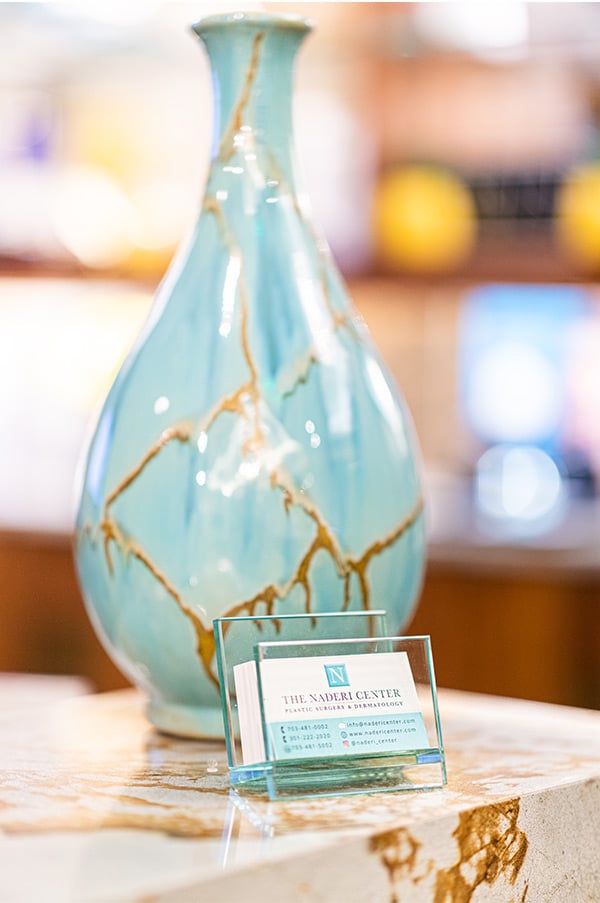
Mild
General Anesthesia
1 to 2 hours
Along the wedge excision of labia minorum. Contouring of the labia majorum can also be done if required
4 to 6 weeks for proper healing to occur
1 week
6 weeks
$4,000 – $6,000
Labiaplasty Expected Results
When a woman has realistic expectations and an understanding of the procedure, labiaplasty can provide a natural and comfortable aesthetic. Patients can expect to achieve a more balanced appearance while addressing any associated discomfort.
- Removal of stretched, excess labial tissue, creating a proportionate, pleasing look to the labia majora and labia minora.
- Decrease in discomfort and pain when wearing tight-fitting clothing or participating in certain physical activities such as cycling.
- Possible opportunity for enjoyable sexual activity, free from pain or discomfort.
Ideal Candidate for Labiaplasty
An ideal candidate for labiaplasty removal surgery is any woman who wishes to improve their vaginal appearance or comfort of her labia. Candidates should have realistic expectations and understand the procedure in order to achieve natural and comfortable results.
An ideal candidate:
- Has labia that are large or misshapen
- Experiences pain or discomfort during sexual intercourse due to excess skin
- Experiences discomfort under jeans or tight clothing
- Has a noticeable “bump” of enlarged labia that can be seen in swimwear or tight pants
- Has no medical conditions that will hinder surgical healing
- Is a non-smoker
- Is a healthy individual without medical conditions that impair healing or increase the risk of cosmetic surgery
Labiaplasty is Becoming More Popular in Reston, VA, and Chevy Chase, MD
Labiaplasty procedures have increased in popularity in recent years, and an increasing number of women are seeking treatment not only for aesthetic concerns but also for functional and/or psychological reasons. Although variation in the shape and size of the labia can be expected, in recent years the trend has been towards smaller and more hidden labia minora. Women may opt to undergo a reduction of their labia minora for reasons varying from aesthetic to functional. According to a study performed in 2008, “32% sought surgery for functional impairment or discomfort, 37% sought surgery for aesthetic purposes, and 31% sought surgery for a combination of these reasons” (RD, 2008). Understanding the full realm of symptoms associated with larger and/or misshapen labia minora is important in discovering how to attain surgical relief. According to several studies, labiaplasty surgery has a satisfaction rate of over 90% in patients (Willis, Wong, & Patel, 2019). As labiaplasty research continues, surgeons are better able to understand reasons for the procedure and are able to advance their techniques for an optimal result.
The increase in popularity of Brazilian waxing, genitalia shaving, and Brazilian laser hair removal has also caused more women to pay attention to their genitalia. Women may compare the appearance of their genitalia to the hairless and flapless or “tucked in” genitalia of women on the internet or in pornography. Unfortunately, exposure to unrealistic media images of female genitalia may make some women feel self-conscious and prompt their desire to pursue vaginal rejuvenation surgery.
Testimonial
“Dr. Naderi is the best! He’s super honest and a master at his craft. His entire staff are at the top of their game- super helpful, responsive and patient. If you’re lucky to get an apt, it’s worth the wait. Thanks Naderi team:)”
Labiaplasty Surgical Techniques
Anatomy of the Labia
In order to better understand labiaplasty techniques, knowledge of the anatomy of the external genitalia is helpful. Below we have labeled parts of the external genitalia that your surgeon may refer to when describing their approach to a labiaplasty.
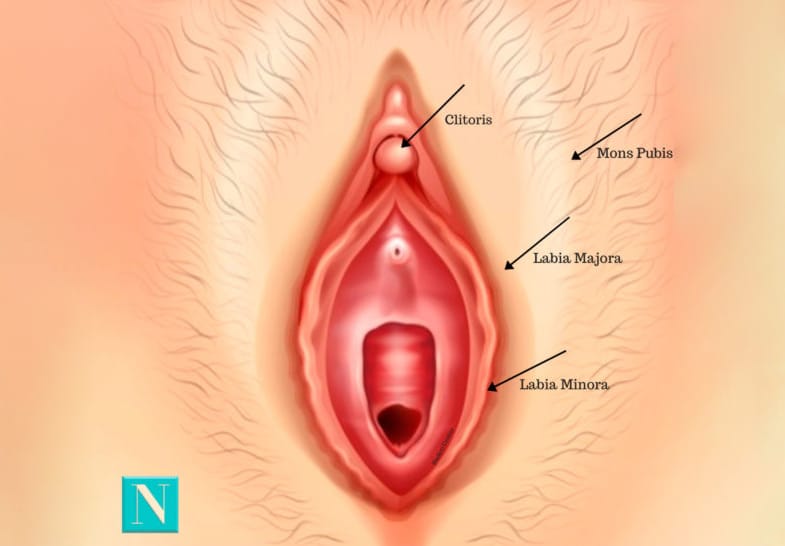
Mons Pubis
The inverted triangular mass of adipose tissue, covered by pubic hair.
Labia Majora
The outer lips of the two folds of vaginal tissue that extend posteriorly from the mons pubis. These folds contain hair and their appearance can vary from “full and tight” to “lax and baggy” (Hamori, Bandwell, & Alinsod, 2017).
Labia Minora
The inner lips of the two folds of tissue that extend posteriorly on each side of the opening into the vagina. These folds are hairless and range in pigmentation.
Clitoris
An oval-shaped erectile organ located below the urethra and connected to the mons pubis. It contains several sensory nerve endings.
Different Labiaplasty Techniques
Wedge Technique
The wedge technique receives its name from the V-shaped “wedge” incisions made on both sides of the labia. The V-shaped wedge is then stitched back together to reduce the most enlarged part of the labia. Our body plastic surgeons prefer this technique because of its ability to address both the height and width of the labia minora. The wedge technique does this by shortening the height of the labia minora from anterior to posterior, while also decreasing the width by removing, typically, the most protuberant part of the minora. Other advantages of the wedge technique are preservation of the outer edge contour, less noticeable scarring, and less sensitivity at the incision line. A disadvantage of this technique would be a higher chance of the incision line separating. However, strictly following post-operative instructions will lessen this likelihood.
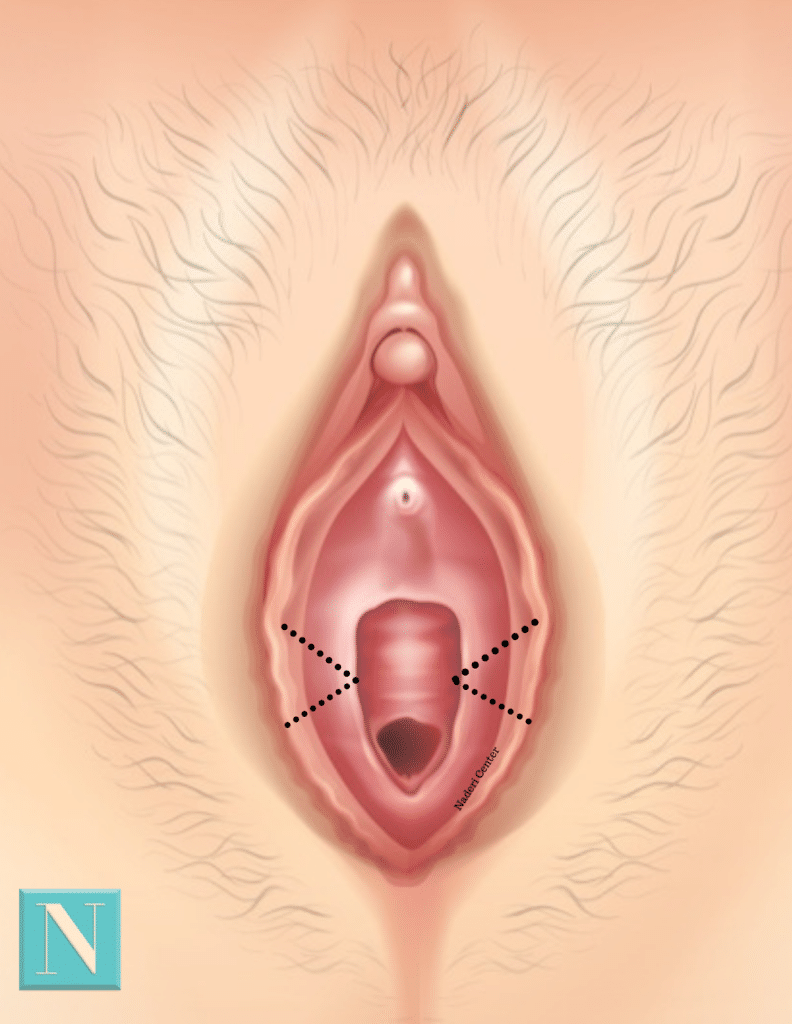
Edge Technique (Linear Technique or Trim Technique)
The edge technique, also known as either the linear or trim technique, consists of the linear removal or trimming of the outer, most protruding edge of the labia. Often, the outer edge of the labia is darker in color, causing self-consciousness in women, and may even be one of the reasons women opt for a labiaplasty procedure. This technique targets the darker-colored portion of the tissue, leaving a more even-toned labia appearance. However, with the incision line following the outer edge of the labia minora, this technique does not preserve the natural edge and contour of the minora and has the highest probability of noticeable scarring.
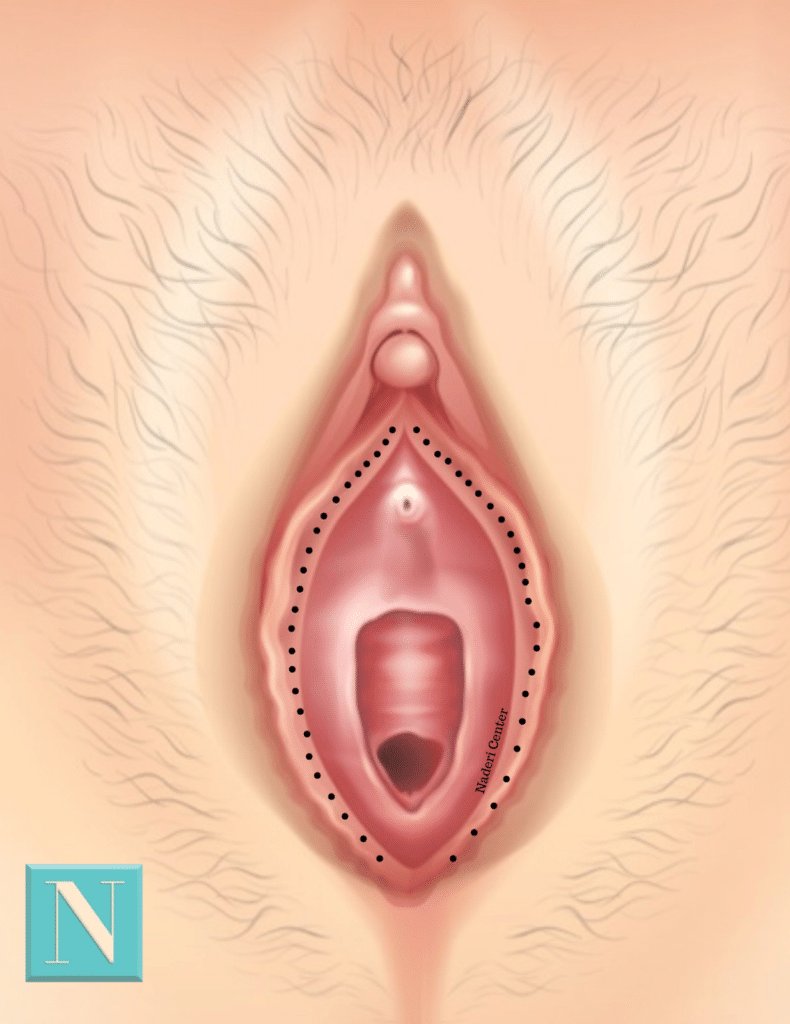
Z-Plasty
Z-plasty is a surgical technique used for many different types of procedures within the plastic surgery field. It was developed for optimal function and aesthetics of scarring. Using Z-plasty on the labia is an extension of the wedge technique and yields very similar advantages. Instead of a V-shaped incision, a Z-shaped incision is used alternatively. It ensures less tension on the incision line, which typically leads to even better scarring.
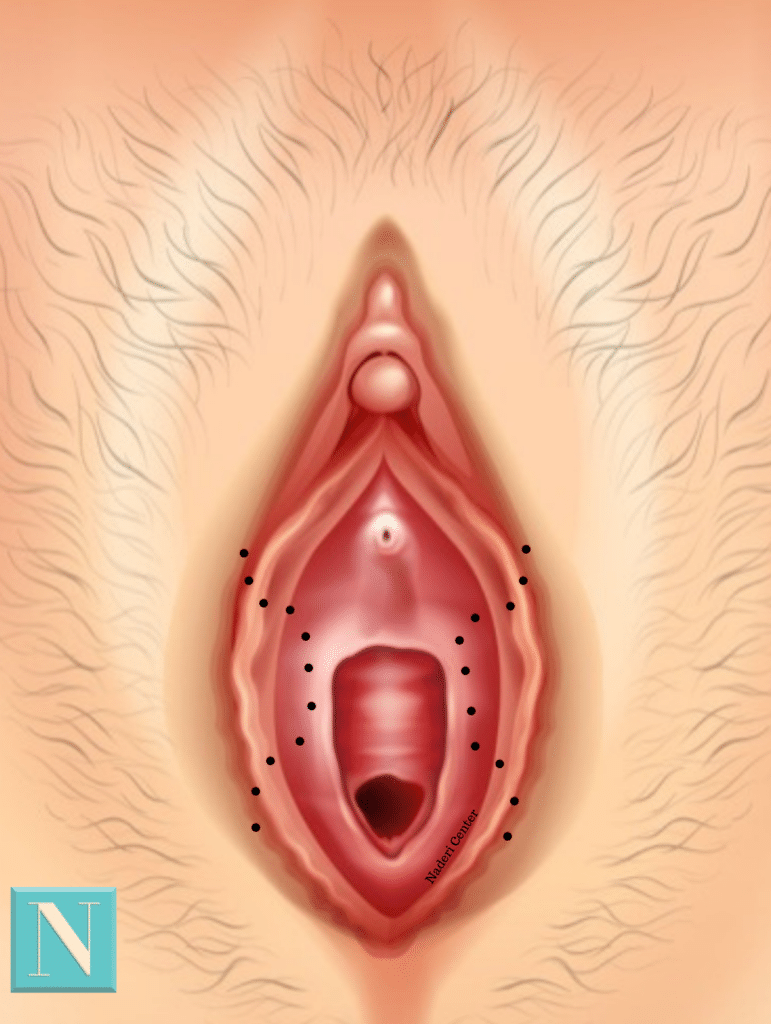
De-epithelialization
The de-epithelialization technique involves oval-shaped incisions made in the inner, most central part of each minora. The procedure takes approximately 30 minutes. The de-epithelialization technique removes this inner part of the minora before the minora are stitched back together. The main advantage of this technique is the preservation of natural labia contours. However, de-epithelialization only reduces the width of the minora while keeping the vertical length the same.
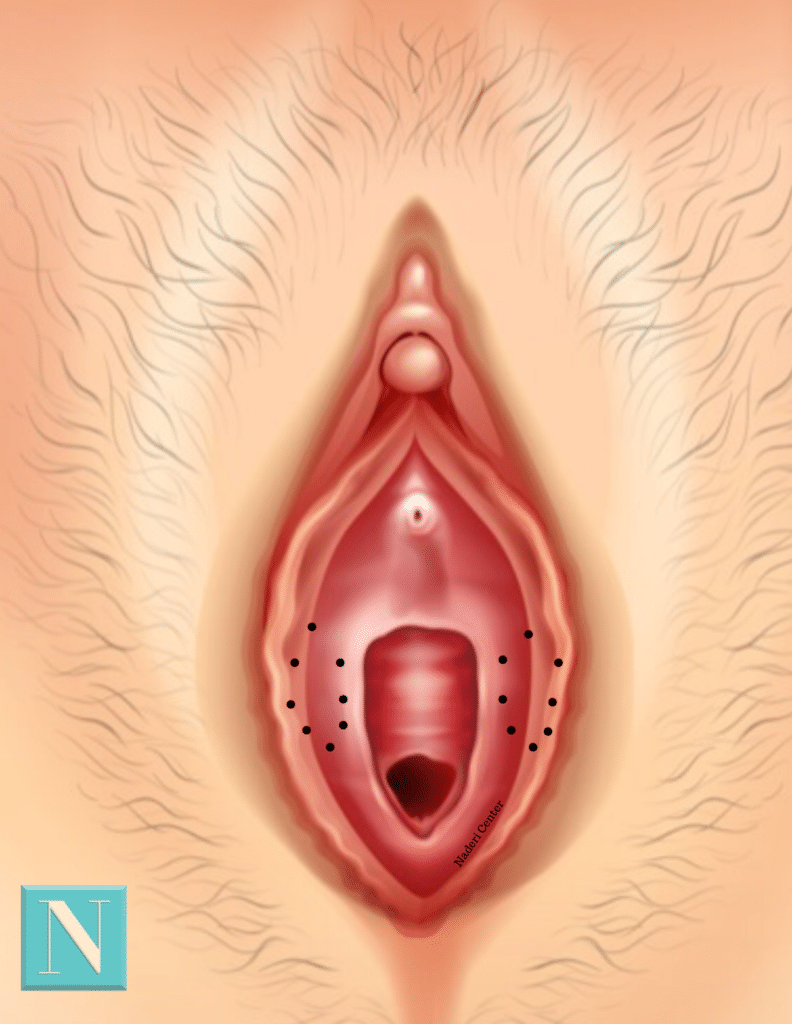
Our Preferred Labiaplasty technique
Our plastic surgeons perform vaginal rejuvenation at an ambulatory surgery facility, where the procedure takes approximately one to two hours under general anesthesia. Women are back home recovering the same afternoon. Our doctors begin by making an excess wedge excision of labia minorum. Contouring of the labia majorum can also be done if it is required. Once the desired youthful appearance of the labia has been achieved, our plastic surgeons will place dissolvable sutures for a proper healing process. Our body plastic surgeons understand that there is a very diverse anatomy when it comes to the female genitalia and there is not one labiaplasty technique that may be performed on every patient. For this reason, our specialists evaluate each patient in order to devise a personalized based on each patient’s specific complaints and what is most bothersome to them. With that being said, there are certain techniques that our body specialists find to be superior to others. Specifically, our surgeons tend to perform more labiaplasty surgeries using the wedge technique; this is because the wedge technique addresses the anterior to the posterior length of the labia minora as well as the over height.
What is “the Barbie” Look?
If you are researching vaginal rejuvenation you may come across a term known as “the Barbie” look or “the Barbie surgery.” “The Barbie” is a procedure that will involve surgically trimming both the labia minora as well as the labia majora. The idea is that a woman’s genitalia will appear smooth and “tucked-in” like those of the plastic doll Barbie.

Cost of Labiaplasty treatment
There are a variety of factors that determine the overall cost of your labiaplasty procedure.
- Surgeons Fee: $4,000 – $6,000
- Anesthesia Fee: depends on the length of the surgical process
- Hospital and Surgical Facility Fees: depend on the length of the procedure
- Pre-Surgical Medical Clearance and Lab Tests: usually covered by medical insurance
- Medication Costs: usually covered by medical insurance
- Follow-Up Visits: included with surgeon’s fee at The Naderi Center
Preparation for your Labiaplasty
At the Naderi Center, we believe the success of any cosmetic procedure can be improved with proper patient preparation. We go above and beyond to make sure that our patients are medically, emotionally, and physically ready for surgery.
Please review our detailed instructions on labiaplasty preparation in link below.
The Labiaplasty Recovery Process
Patients should expect their labiaplasty recovery time to take about one week. Most women are back at work or school in a few days. There will be no need to remove sutures, as our body specialists use dissolvable stitches. Bruising and swelling are common around the labia; however, this will resolve. Our surgeons will prescribe any necessary pain medication, although discomfort after labiaplasty is generally mild. Exercising and sexual activity should be postponed for four to six weeks after surgery, allowing the labia time to fully heal.
Risks, Safety, and Potential Complications of Labiaplasty
Our body plastic surgeons have years of experience in vaginal rejuvenation procedures and bring the most innovative techniques to their patients. Today’s vaginal rejuvenation procedures are safer and more effective than ever before, although there is always a small chance for complications to occur.
Pain during intercourse can be expected after surgery; however, this typically resolves itself within a few weeks after surgery. Our plastic surgeons use absorbable sutures to maximize patient comfort and reduce pain during recovery to ensure that patients can resume their normal activities such as pain-free intercourse. Patients should wait at least four to six weeks before engaging in any sexual activity to ensure proper healing of the labia. Patients should choose an experienced, skilled board-certified plastic surgeon, such as our surgeons, to ensure they receive satisfactory results. During the initial consultation appointment, our plastic surgeons will discuss the risks and complications that can accompany vaginal rejuvenation techniques.
Potential Complications after a Labiaplasty can include
- Risk of General Anesthesia
- Excessive bleeding
- Unfavorable scarring
- Infection
- Nerve damage or loss of sensation in the operated area
- Pain with Intercourse
- Chronic dryness of the vaginal area
- Flap necrosis, or death of cells in the living tissue
- Need for Revision Surgery
Labiaplasty Specialist
Our plastic surgeons understand their patients’ most delicate aesthetic desires, allowing them to create a personalized vaginal rejuvenation treatment plan to meet these needs. They bring years of experience to each procedure and are regarded as the country’s most sought-after vaginal rejuvenation surgeons. Our surgeons’ techniques can be performed alone for excellent results, but may also be included in a more extensive physical rejuvenation process, such as the Mommy Makeover.
Women interested in vaginal rejuvenation should begin their journey by making a consultation appointment with our doctors. During this time, our surgeons will review the medical history, perform a brief physical exam, and fully explain the vaginal rejuvenation technique.
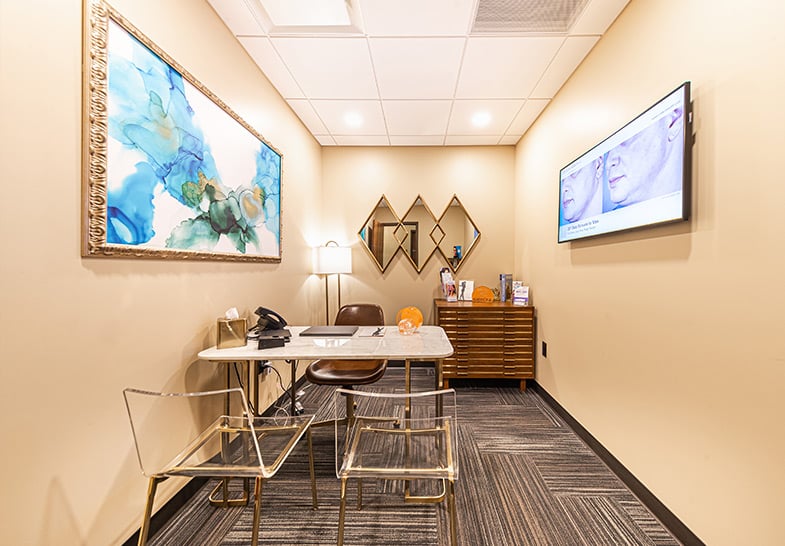
Our surgeon will listen to the patient’s cosmetic and functional concerns and answer any questions about the procedure. Once it has been determined that vaginal rejuvenation is the right technique to meet an individual’s needs, our specialists will create a personalized treatment plan.
To get additional information on the vaginal rejuvenation process at The Naderi Center, contact our Northern Virginia office at 703-481-0002 or our Chevy Chase, Maryland office at 301-222-2020. Consultations can be scheduled in person, as well as online. The Naderi Center has two convenient locations, easily reached from anywhere in the Washington D.C. metropolitan area. Anyone coming from outside of Maryland, Virginia, or Washington D.C. may want to discuss travel advice and reservation assistance with one of the Naderi Center’s expert patient coordinators.
Labiaplasty FAQs
What is the difference between Vaginoplasty and Labiaplasty?
A vaginoplasty and labiaplasty both fit under the classification of vaginal rejuvenation surgery. A “Vaginoplasty” refers to a surgical procedure that “tightens” vaginal walls and the vaginal canal. Patients typically seek a vaginoplasty after childbirth to increase sexual gratification, vaginal dryness, and excessive vaginal vault relaxation. Vaginal tightening can be performed both surgically as well as nowadays there are a variety of different non-invasive laser techniques. Labiaplasty is a cosmetic surgical procedure to remove excess tissue of the labia minora and majora. Patients typically seek labiaplasty due to having misshapen labia.
Will labiaplasty surgery enhance and improve sexual intercourse?
Often times women with enlarged labia experience embarrassment, low self-confidence, and hesitation towards participating in sexual intercourse. However, the effect tends to be more psychological for many. During a study performed on “The Impact of Labiaplasty on Sexuality”, researchers found that the after effect of patients who underwent the procedure showed the most improvement in the “pain and enjoyment domains” of sex. (Turini T, 2018). Overall the researchers found the procedure to have a positive influence on functionality during intercourse Enlarged labia can also have a physical effect on sexual intercourse and can in some cases hinder getting pregnant by making penile penetration more challenging.
How do I know if I am a good candidate for the labiaplasty procedure?
A good candidate for labiaplasty is a patient who is experiencing discomfort, irritation, aesthetic dissatisfaction, or self-consciousness due to the size, shape, and/or functionality of their labia. Patients often seek a labiaplasty procedure for both cosmetic and medical reasons.
Will I have a lot of pain after my labiaplasty procedure?
Pain level after labiaplasty is typically mild to moderate. It is normal to experience discomfort and swelling for a few days to weeks following the procedure. Symptoms are manageable with cold compresses and pain medication.
When can I resume sexual intercourse after a labiaplasty procedure?
Healing of the labia after surgery typically takes around 4-6 weeks. However, it is important to attend all follow-up appointments with the surgeon so the surgeon can evaluate and clear you for sexual intercourse based on your progress in recovery.
Should I wait to have children first before undergo my labiaplasty?
No. When to undergo a labiaplasty procedure is largely up to the patient’s own personal discretion and preference. If the patient is fully educated on the procedure and its potential risks, has found an experienced surgeon, and feels ready for the labiaplasty procedure then there is no reason to wait until after childbirth.
Will there be scars after surgery? If so, how big will it look?
Scars will be minimal after surgery. Our breast and body plastic surgeons prefer the wedge-type labiaplasty, as this makes resulting scars virtually undetectable.
Is Labiaplasty covered by insurance?
In some instances where a labiaplasty is not considered to be an elective cosmetic procedure and is done more for infertility issues, it may be covered by your health insurance. The Naderi Center does not participate with insurance for the labiaplasty procedure.
Can I have other procedures performed simultaneously with my labiaplasty?
Yes, it is common for our patients to have more than one procedure performed at the same time as their labiaplasty. Often times a “mommy makeover” involves breast augmentation as well as a tummy tuck and breast lift performed at the same time as a labiaplasty.
What labiaplasty office is near me?
If you live in the states of Virginia or Maryland, The Naderi Center for Plastic Surgery and Dermatology offers labiaplasty among its services. For a full list of services, please visit our Locations page.
Willis RN, Wong CS, Patel BC. Labiaplasty Labia Minora Reduction. [Updated 2019 Jun 10]. In: StatPearls [Internet]. Treasure Island (FL): StatPearls Publishing; 2019 Jan-. Available here.
RD, M. (2008). Labiaplasty of the labia minora: patients’ indications for pursuing surgery. – PubMed – NCBI. [online] Ncbi.nlm.nih.gov. Available at: [Accessed 5 Apr. 2019].
Turini T, e. (2018). The Impact of Labiaplasty on Sexuality. – PubMed – NCBI. [online] Ncbi.nlm.nih.gov. Available at: [Accessed 5 Apr. 2019].
Shahrooz Sean Kelishadi, Joshua Brandon Elston, Arun Jay Rao, John Paul Tutela, Nana N. Mizuguchi, Posterior Wedge Resection: A More Aesthetic Labiaplasty, Aesthetic Surgery Journal, Volume 33, Issue 6, August 2013, Pages 847–853, here.
Christine A Hamori, Paul Banwell, Red Alinsod (2017). Introduction. Female Cosmetic Genital Surgery-Concepts, Classification, and Techniques. New York: Thieme Medical Publishers Inc.
Textbook online: Simplified classification for labial protrusion
